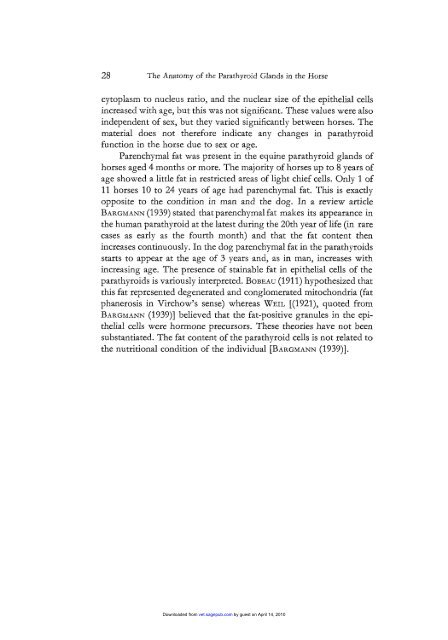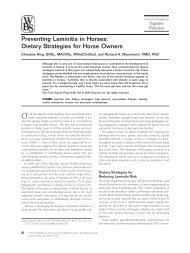Nutritional Secondary Hyperparathyroidism in the Horse
Nutritional Secondary Hyperparathyroidism in the Horse
Nutritional Secondary Hyperparathyroidism in the Horse
You also want an ePaper? Increase the reach of your titles
YUMPU automatically turns print PDFs into web optimized ePapers that Google loves.
28 The Anatomy of <strong>the</strong> Parathyroid Glands <strong>in</strong> <strong>the</strong> <strong>Horse</strong><br />
cytoplasm to nucleus ratio, and <strong>the</strong> nuclear size of <strong>the</strong> epi<strong>the</strong>lial cells<br />
<strong>in</strong>creased with age, but this was not significant. These values were also<br />
<strong>in</strong>dependent of sex, but <strong>the</strong>y varied significantly between horses. The<br />
material does not <strong>the</strong>refore <strong>in</strong>dicate any changes <strong>in</strong> parathyroid<br />
function <strong>in</strong> <strong>the</strong> horse due to sex or age.<br />
Parenchymal fat was present <strong>in</strong> <strong>the</strong> equ<strong>in</strong>e parathyroid glands of<br />
horses aged 4 months or more. The majority of horses up to 8 years of<br />
age showed a little fat <strong>in</strong> restricted areas of light chief cells. Only 1 of<br />
11 horses 10 to 24 years of age had parenchymal fat. This is exactly<br />
opposite to <strong>the</strong> condition <strong>in</strong> man and <strong>the</strong> dog. In a review article<br />
BARGMANN (1939) stated that parenchymal fat makes its appearance <strong>in</strong><br />
<strong>the</strong> human parathyroid at <strong>the</strong> latest dur<strong>in</strong>g <strong>the</strong> 20th year of life (<strong>in</strong> rare<br />
cases as earIy as <strong>the</strong> fourth month) and that <strong>the</strong> fat content <strong>the</strong>n<br />
<strong>in</strong>creases cont<strong>in</strong>uously. In <strong>the</strong> dog parenchymal fat <strong>in</strong> <strong>the</strong> parathyroids<br />
starts to appear at <strong>the</strong> age of 3 years and, as <strong>in</strong> man, <strong>in</strong>creases with<br />
<strong>in</strong>creas<strong>in</strong>g age. The presence of sta<strong>in</strong>able fat <strong>in</strong> epi<strong>the</strong>lial cells of <strong>the</strong><br />
parathyroids is variously <strong>in</strong>terpreted. BOBEAU (1 91 1) hypo<strong>the</strong>sized that<br />
this fat represented degenerated and conglomerated mitochondria (fat<br />
phanerosis <strong>in</strong> Virchow’s sense) whereas WEIL [(1921), quoted from<br />
BARGMANN (1 93591 believed that <strong>the</strong> fat-positive granules <strong>in</strong> <strong>the</strong> epi<strong>the</strong>lial<br />
cells were hormone precursors. These <strong>the</strong>ories have not been<br />
substantiated. The fat content of <strong>the</strong> parathyroid cells is not related to<br />
<strong>the</strong> nutritional condition of <strong>the</strong> <strong>in</strong>dividual [BARGMANN (1 939)].<br />
Downloaded from<br />
vet.sagepub.com by guest on April 14, 2010



